
ZoneCard is a travel card issued by the Strathclyde Partnership for Transport, formerly Strathclyde Passenger Transport in Scotland.

ZoneCard is a travel card issued by the Strathclyde Partnership for Transport, formerly Strathclyde Passenger Transport in Scotland.
The scheme divides the SPT area into 9 regions distinguished by a letter
These are further subdivided into zones dividing the main towns of the area for example Ayr, Prestwick and Troon are in A1, A2 and A3 respectively; there are 77 zones in total. A traveller with a ticket for either G1 or G2 is also able to travel within the shaded city centre area, but travel into an outer Glasgow zone (G3 to G8) requiems a minimum of three zones. Tickets with three Glasgow zones are valid for travel in all Glasgow zones (G1 to G8). The city centre is served by both inner Glasgow zones, and purchasing one of these entitles the user to use the subway system in both areas.
A child's zonecard with 6 zones or an adult zonecard with 13 zones, entitles the user to travel throughout all zones.
A ZoneCard consists of a photocard and a paper counterpart which displays the validity period and is used for operating the barriers on Glasgow's Subway. Previously, passengers who have validated their tickets for the Subway needed to have their tickets manually checked at the ticket barriers at Glasgow Queen Street station because the barriers accept only standard-sized Subway tickets. In 2004, the Glasgow Queen Street barriers were updated so that ZoneCards did not need validation to operate them. The card can be purchased in durations of 1 week, 4 weeks, 10 weeks, and 1 year.
The ZoneCard can be used with any participating transport provider within the zones that the holder has purchased. With a total of approximately 70 transport providers—across bus, rail, and ferry services—in the scheme, there are very few companies who do not accept ZoneCards. The only TOC which doesn't accept ZoneCards is TransPennine Express.[ citation needed ]
Operators criticise the complexity of the zone system, which consists of 77 zones. By comparison, Transport for London's scheme consists of 9 zones despite containing 90 more underground stations than the SPT does rail stations. However, the TfL system only covers 614 square miles (1,600 km2), an area slightly smaller than South Lanarkshire. In addition, the SPT bus network is far larger due to the greater size of its zone system.
The revenue from the scheme is split between the participating operators (the administration costs are absorbed by SPT) based on a number of factors, such as the number of routes operated by a provider, an annual user survey, and passenger counts by SPT officials. Some operators (notably Abellio ScotRail) are guaranteed a certain percentage of the revenue regardless of these factors but more recently Avanti West Coast, LNER and CrossCountry also receive revenue from ZoneCards as their trains provide services between Glasgow and Motherwell and vice versa. Aside from the previously mentioned administration costs, the scheme is designed to be self-supporting, unlike some other tickets which are subsidised with public money to help the significant percentage of households in the region that do not have access to a car.

The Glasgow Subway is an underground light metro system in Glasgow, Scotland. Opened on 14 December 1896, it is the third-oldest underground rail transit system in Europe after the London Underground and the Budapest Metro. It is also one of the very few railways in the world with a track running gauge of 4 ft wide. Originally a cable railway, the subway was later electrified, but the double-track circular line was never expanded. The line was originally known as the Glasgow District Subway, and was later renamed Glasgow Subway Railway. In 1936 it was renamed the Glasgow Underground. Despite this rebranding, many Glaswegians continued to refer to the network as "the Subway". In 2003, the name "Subway" was officially readopted by its operator, the Strathclyde Partnership for Transport (SPT).
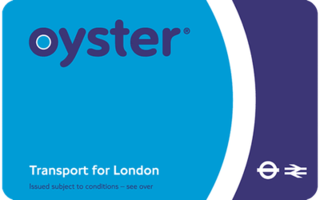
The Oyster card is a payment method for public transport in London in England, United Kingdom. A standard Oyster card is a blue credit-card-sized stored-value contactless smart card. It is promoted by Transport for London (TfL) and can be used on travel modes across London including London Buses, London Underground, the Docklands Light Railway (DLR), London Overground, Tramlink, some river boat services, and most National Rail services within the London fare zones. Since its introduction in June 2003, more than 86 million cards have been used.

The Travelcard is an inter-modal travel ticket for unlimited use on the London Underground, London Overground, Elizabeth line, Docklands Light Railway, London Trams, London Buses and National Rail services in the Greater London area. Travelcards can be purchased for a period of time varying from one day to a year, from Transport for London, National Rail and their agents. Depending on where it is purchased, and the length of validity, a Travelcard is either printed on a paper ticket with a magnetic stripe or encoded onto an Oyster card, Transport for London's contactless electronic smart card. The cost of a Travelcard is determined by the area it covers and, for this purpose, London is divided into a number of fare zones. The Travelcard season ticket for unlimited travel on London Buses and the London Underground was launched on 22 May 1983 by London Transport. One Day Travelcards and validity on other transport modes were added from 1984 onwards. The introduction of the Travelcard caused an increase in patronage and reduced the number of tickets that needed to be purchased by passengers.

Strathclyde Partnership for Transport (SPT) is a regional transport partnership for the Strathclyde area of western Scotland. It is responsible for planning and coordinating regional transport, especially the public transport system in the area, including responsibility for operating the Glasgow Subway, the third oldest in the world.
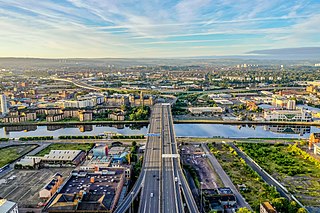
The city of Glasgow, Scotland has a transport system encompassing air, rail, road, and an underground light metro line. Prior to 1962, the city was also served by trams. Commuters travelling into Glasgow from the neighbouring local authorities of North and South Lanarkshire, Renfrewshire, East Renfrewshire, and East and West Dunbartonshire have a major influence on travel patterns, with tens of thousands of residents commuting into the city each day. The most popular mode of transport in the city is the car, used by two thirds of people for journeys around the city.

Fares to use the Toronto Transit Commission (TTC) transit system in Toronto, Ontario, Canada, can be paid with various media. The price of fares varies according to age, occupation, and income level of riders.
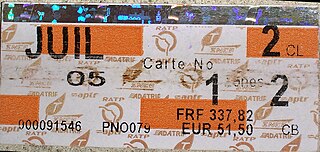
The carte orange was a pass for the public transportation system in Paris and the surrounding Île-de-France region. A holder of the pass was entitled to unlimited use of the public transit system within a given period of time, with Cartes oranges being available for durations of one week or one month. The carte orange was discontinued in February 2009, and replaced by Navigo semaine and Navigo mois on a Navigo card.

Partick is an interchange station in the Partick area of Glasgow, Scotland. Along with the adjacent bus station, it forms one of the main transport hubs in Glasgow. As of 2022, it is the fifth-busiest station in Scotland. The station is served by Glasgow Subway and ScotRail services and was one of the first to receive bilingual English and Gaelic signs, due to the significant Gaelic-speaking population in the surrounding Partick area.

Buchanan Street subway station is a station on the Glasgow Subway in Scotland. It serves Buchanan Street, which is popular with shoppers. Close to Buchanan Bus Station and providing interchange with Glasgow Queen Street railway station via a travelator, it is the busiest station on the Subway, with 2.54 million passengers in the 12 months ending 31 March 2005.

Hillhead subway station is a station on the Glasgow Subway, serving the Hillhead area of Glasgow, Scotland. The entrance is located on Byres Road.

St Enoch subway station is a station on the Glasgow Subway in Scotland. It is located north of the River Clyde in Glasgow city centre. Although it does not have direct interchange with the main line railway, it is located approximately halfway between Glasgow Central railway station and Argyle Street railway station, within a few minutes' walk to both. The subway station is accessible via St Enoch Square.

Myki, stylised as myki, is a reloadable credit card-sized contactless smart card ticketing system used for electronic payment of fares on most public transport services in Melbourne and regional Victoria, Australia. Myki replaced the Metcard ticketing system and became fully operational at the end of 2012.
Public transport ticketing in New South Wales, Australia operated using magnetic-stripe technology between 1989 and 2016. This ticketing system, known variously as the Automated fare collection system, STATS and, from 2010, MyZone, was progressively replaced by a contactless smart card called Opal between 2012 and 2016.

The OV-chipkaart is a contactless smart card system used for all public transport in the Netherlands. First introduced in the Rotterdam Metro in April 2005, it has subsequently been rolled out to other areas and travel modes. It fully replaced the national strippenkaart system for buses, trams, and metro trains in 2011, and the paper ticket system for rail travel in July 2014.

A transit pass or travel card, often referred to as a bus pass or train pass etc., is a ticket that allows a passenger of the service to take either a certain number of pre-purchased trips or unlimited trips within a fixed period of time.
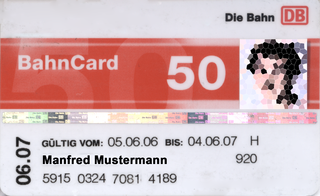
BahnCard is a discount subscription programme offered by Deutsche Bahn (DB), the German national railway company. Unlike airline loyalty programs, but similarly to the UK Railcard, the BahnCard entitles the passenger to a discount price and must be purchased prior to travel. The BahnCard is offered in a non-business and a business version called BahnCard Business. Non-business BahnCard contracts are automatically renewed each year, unless they are cancelled with sufficient notice. Three variants of BahnCard are sold by Deutsche Bahn: The BahnCard 25, the BahnCard 50, and the Mobility BahnCard 100. The first two variants allow passengers to get 25% and 50% discount respectively on standard long-distance rail fares, while the Mobility BahnCard 100 is a type of annual ticket that allows free unlimited travel on most of the German railway network for a fixed price. The (non-business) BahnCard 25/50 are valid for one year and can only be purchased by subscription. If they are not canceled no later than six weeks before the expiry date, their term is automatically extended by another year. BahnCard Business 25/50 are also valid for one year but require no cancellation. Unlike the personal BahnCard, BahnCard Business can be combined with the discount that is granted to large-volume business customers.
The go card is an electronic smartcard ticketing system developed by Cubic Corporation, which is currently used on the Translink public transport network in South East Queensland. To use the go card, users hold the card less than 10 cm away from the reader to "touch on" before starting a journey, and must do the same to "touch off" the service at the end of the journey. The cost of each journey is deducted from the go card balance.
GO Transit is the inter-regional transportation authority of the Golden Horseshoe, which includes the Greater Toronto and Hamilton Area. It is Canada's oldest regional transit system, first serving passengers in 1967.
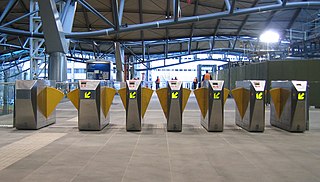
An automated fare collection (AFC) system is the collection of components that automate the ticketing system of a public transportation network - an automated version of manual fare collection. An AFC system is usually the basis for integrated ticketing.
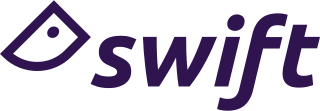
Swift is an electronic ticketing scheme developed by Transport for West Midlands for use on public transport in the West Midlands metropolitan area in England, similar to the Oyster card in Greater London. Rather than being a single card, it is a range of travel cards under a common name.